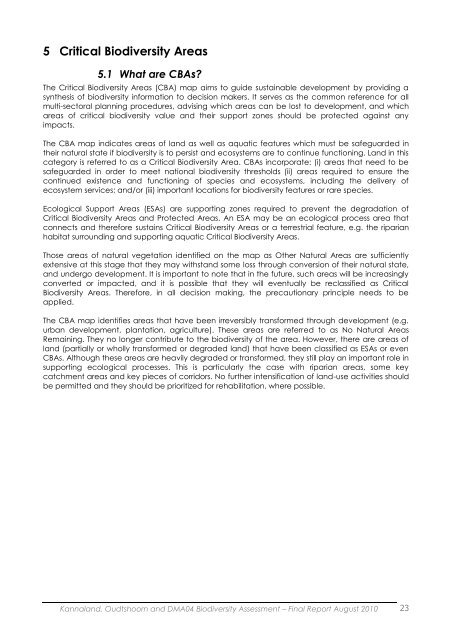Little Karoo Biodiversity Assessment - Biodiversity GIS - SANBI
Little Karoo Biodiversity Assessment - Biodiversity GIS - SANBI
Little Karoo Biodiversity Assessment - Biodiversity GIS - SANBI
You also want an ePaper? Increase the reach of your titles
YUMPU automatically turns print PDFs into web optimized ePapers that Google loves.
5 Critical <strong>Biodiversity</strong> Areas5.1 What are CBAs?The Critical <strong>Biodiversity</strong> Areas (CBA) map aims to guide sustainable development by providing asynthesis of biodiversity information to decision makers. It serves as the common reference for allmulti-sectoral planning procedures, advising which areas can be lost to development, and whichareas of critical biodiversity value and their support zones should be protected against anyimpacts.The CBA map indicates areas of land as well as aquatic features which must be safeguarded intheir natural state if biodiversity is to persist and ecosystems are to continue functioning. Land in thiscategory is referred to as a Critical <strong>Biodiversity</strong> Area. CBAs incorporate: (i) areas that need to besafeguarded in order to meet national biodiversity thresholds (ii) areas required to ensure thecontinued existence and functioning of species and ecosystems, including the delivery ofecosystem services; and/or (iii) important locations for biodiversity features or rare species.Ecological Support Areas (ESAs) are supporting zones required to prevent the degradation ofCritical <strong>Biodiversity</strong> Areas and Protected Areas. An ESA may be an ecological process area thatconnects and therefore sustains Critical <strong>Biodiversity</strong> Areas or a terrestrial feature, e.g. the riparianhabitat surrounding and supporting aquatic Critical <strong>Biodiversity</strong> Areas.Those areas of natural vegetation identified on the map as Other Natural Areas are sufficientlyextensive at this stage that they may withstand some loss through conversion of their natural state,and undergo development. It is important to note that in the future, such areas will be increasinglyconverted or impacted, and it is possible that they will eventually be reclassified as Critical<strong>Biodiversity</strong> Areas. Therefore, in all decision making, the precautionary principle needs to beapplied.The CBA map identifies areas that have been irreversibly transformed through development (e.g.urban development, plantation, agriculture). These areas are referred to as No Natural AreasRemaining. They no longer contribute to the biodiversity of the area. However, there are areas ofland (partially or wholly transformed or degraded land) that have been classified as ESAs or evenCBAs. Although these areas are heavily degraded or transformed, they still play an important role insupporting ecological processes. This is particularly the case with riparian areas, some keycatchment areas and key pieces of corridors. No further intensification of land-use activities shouldbe permitted and they should be prioritized for rehabilitation, where possible.Kannaland, Oudtshoorn and DMA04 <strong>Biodiversity</strong> <strong>Assessment</strong> – Final Report August 2010 23
















